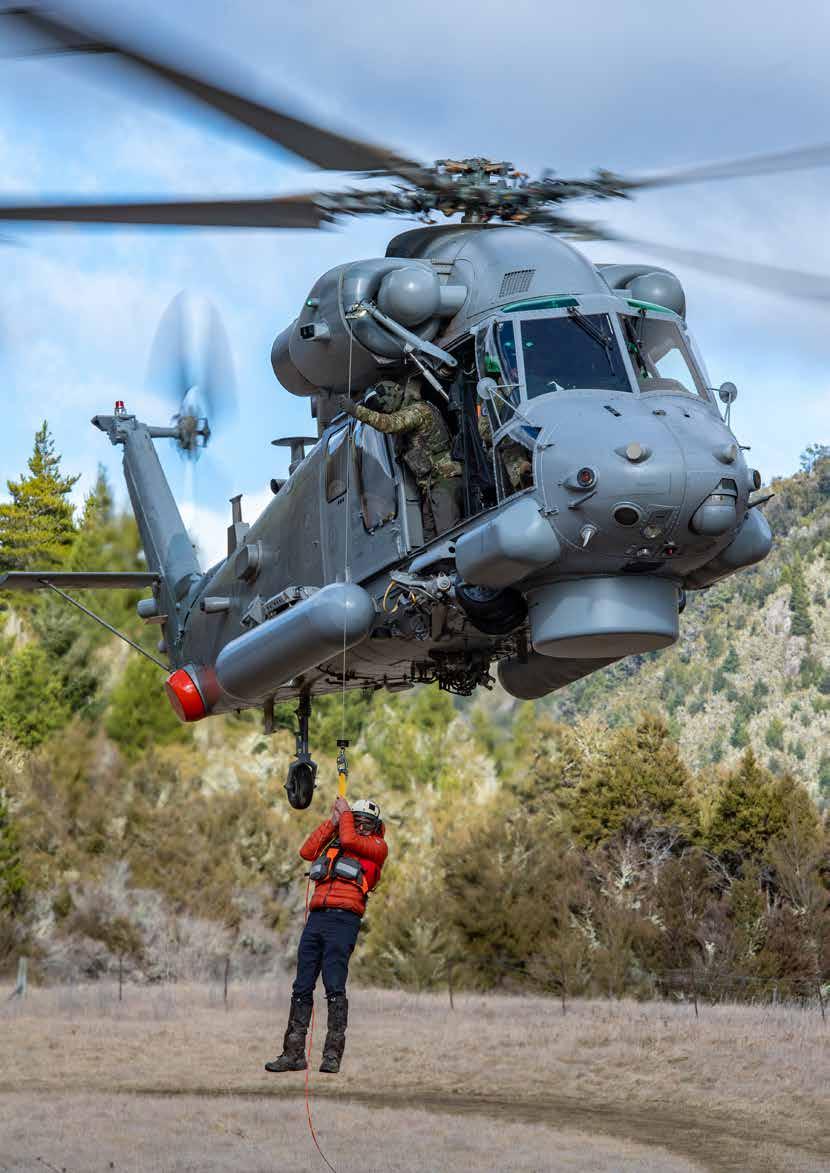DEFENCE POLICIES TE MANA ACTIVITIES
MIDDLE EAST DRUG BUSTS
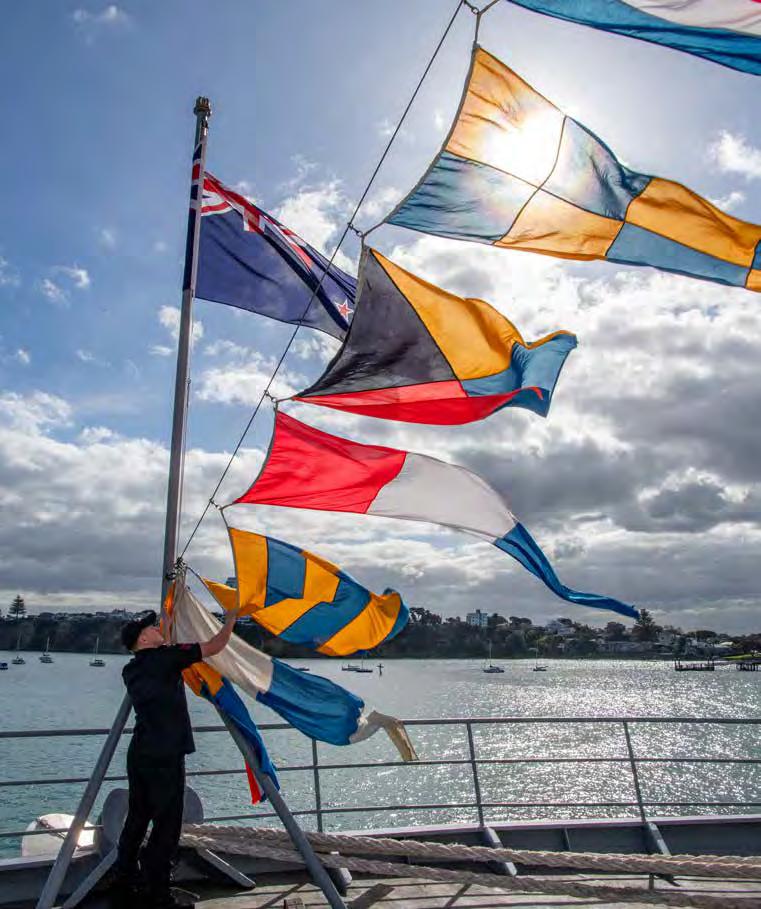
# 2 8 0 S E P 2 3 TE TAUA MOANA I TĒNEI RĀ
NZNavy navy.mil.nz
NZDefenceForce
24 Chefs on exchange with the Coast Guard
25 Customs Dogs practise with Navy
27 High School student in Reserve Force
28 Navy Captains’ Hui
30 In Company with India

31 Medals for Merchant Navy veteran
32 Hockey wins
Navy Today is the official magazine of the Royal New Zealand Navy. Established to inform, inspire and entertain serving and former members of the RNZN, their families, friends and the wider Navy Community.
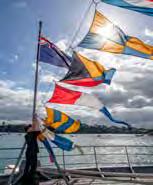

Published by: Defence Public Affairs HQ NZ Defence Force Wellington, New Zealand
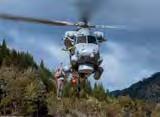
Editor: Andrew Bonallack
Email: navytoday@nzdf.mil.nz
Design and Layout: Defence Public Affairs
Printed by: Bluestar
Private Bag 39996, Wellington
Distribution: Email: navytoday@nzdf.mil.nz
Contributions are welcomed, including stories, photographs and letters. Please submit stories and letters by email in Microsoft Word or the body of an email. Articles up to 500 words welcomed, longer if required by the subject. Please consult the editor about long articles. Digital photos submitted by email also welcomed, at least 500kb preferred. Stories published in Navy Today cannot be published elsewhere without permission.
Copy deadline is the 15th of the month for the following issue. Subject to change.
Views expressed in Navy Today are not necessarily those of the RNZN or the NZDF.
Defence Careers: Phone: 0800 1FORCE (0800 136 723) www.defencecareers.mil.nz
Changing Address?
To join or leave our mailing list, please contact: Email: navytoday@nzdf.mil.nz
Front Cover: ACWS Dylan Crick dresses HMNZS CANTERBURY in signal flags during a trade photoshoot.
Back Cover: A Seasprite helicopter conducts winch training in Marlborough with members of LandSAR.
Front and Back Cover
Photographer: PO Chris Weissenborn
2 | Navy Today #280 Contents 04 Launch of Defence policies 10 AOTEAROA departs for Asia 11 Middle East Drug busts 12 MATATAUA at Talisman Sabre 14 Seasprites in the mountains 20 Mobile Weapons Training Simulator 22 Divisional Hui 23 MID Ngawaka profile
“We got treated so well, we felt superwelcomed. The crew would shout: ‘The Kiwis!’ when they saw us.”
– ACH Alice Wyatt and LCH Monique Manuel aboard USCGC STRATTON
14 24
32
Yours Aye
Captain Colleen Smith, Chief Naval Engineer

Welcome to spring, the days are getting longer, new plant growth is appearing and animals are being born. For our Navy however, there is no change in our mahi, it continues unabated and unceasing, the nature of our work is unchanged by the ebb and flow of the seasons. Our Navy is always either undertaking, preparing to undertake, or recovering from undertaking tasks for New Zealand.
For our Navy’s engineers and technicians, this is especially true. Regardless of whether a ship is at sea or alongside, there are always important tasks that need to be performed; operation of the ship’s plant, maintenance that keeps the ship’s equipment working, and maintenance to repair equipment that has become defective. Technicians and engineers are an essential part of the Navy’s workforce, and I am indescribably proud to lead them in my role as Chief Naval Engineer.
These trades and their expertise are in high demand. Many of our ships are getting on in their years, and this makes the task of the technicians and engineers much more demanding due to the extra care and attention that is required to keep ageing equipment working. Additionally, large capability acquisition projects, like the Frigate Systems Upgrade, require the expertise of technicians and engineers from the inception of the project, all the way through to the final stage of operational release.
Technicians and engineers are in demand across New Zealand’s economy too, and we are challenged to compete with the remuneration that private industry can offer. In the recent past our technicians especially have been leaving the Navy at rates much higher than usual, and this is intensifying the demand on those that stay.
We do, however, offer a work environment that is unique. We do things other organisations don’t do, operate and maintain equipment that is unique to the military, and have a teamwork ethos that is often considered our superpower and constantly rated as one of the best elements of our organisation.
These increasing and at-the-sametime competing demands are giving us good reason to focus on how we prioritise our mahi. Currently, due to technical personnel shortages, our Navy is having to prioritise which ships it is crewing and operating. On board ship, the technicians and engineers are having to prioritise what maintenance to do, and ashore, in the dockyard, our engineering support organisation is having to prioritise how it utilises its limited technical and engineering workforce in support of ships in maintenance.
We are prioritising our work not only because we have fewer technicians and engineers than we need (and as a result do not have the capacity to meet the current demand), but also because we need to look after those that we have. We need to carefully manage the workload of our technical and engineering workforce so that they are available to train the new technicians and engineers that we need.
These are professions that require prolonged training and a formal qualification. They are an essential part of the Navy and of getting and keeping ships at sea. I wish to thank all our technicians and engineers for their contribution to our Navy, Te Taua Moana, for what they do, and the pride and spirit in which they do it.
Whakawhetai ki a koe mo to mahi!
Nāu te rourou, nāku te rourou, ka ora ai te iwi. (With your food basket and my food basket the people will thrive.)
He heramana ahau.
Navy Today #280 | 3
CHARTING NEW WATERS: WHAT NEXT FOR TE TAUA MOANA O AOTEAROA?

4 | Navy Today #280
Captain Stephen Lenik RNZN analyses the recent Defence Policy Review and its implications for the Royal New Zealand Navy.
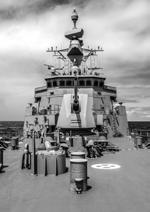
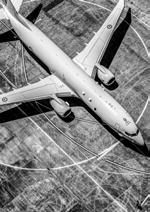
Our Navy has a proud and storied history, and it has consistently adapted to meet the evolving maritime challenges of its time. Yet now we need to adapt to face challenges more significant than any we have faced in a while. Chief among these challenges are the security threats borne from strategic competition between the United States and an increasingly assertive China. Additionally, this challenge is compounded by increasing frequency and ferocity of the consequences of climate change.
In response to this strategic situation, the Defence Policy and Strategy Statement (DPSS) and Future Force Design Principles (FFDP) were launched at Parliament on 4 August. Together, these documents provide a clear-eyed view of the threats facing New Zealand as well as setting out a blueprint guiding the configuration of a revitalised New Zealand Defence Force and illuminating how future capabilities will be used to address the security threats.
At the launch of the DPSS and FFDP the Prime Minister stated, “the world today is contending with a range of complex and disruptive security challenges…The domestic and international security environment has changed, and our preparedness needs to change too – to be cleareyed on risks and to put in place the right capabilities to be effective”. This statement from the PM heralds a new era for the NZDF and articulates that investment in a combat-capable Defence Force is required.
Moreover, at the same event, the Minister of Defence, Andrew Little remarked, “we take the world as it is, not how we would like it to be. It is essential to respond appropriately to the full range of national security threats to New Zealand and our interests”.
As the old adage goes ‘we may not be interested in war, but war may be interested in us’. Accordingly we must be prepared to meet the full gamut of threats to our way of life. Indeed, at the public launch the Minister of Defence went on to say that “we are investing to modernise our capabilities across land, sea and air, and are strengthening our relationships with friends and partners in the Pacific and beyond.” This statement points to a way forward for the NZDF in the coming years and one that seeks to address challenges to our security that span from activities in the ‘grey zone’ to those of state-on-state conflict. The Minister’s statement reflects the need to be proactive; address threats ‘upstream’ before they manifest at our borders, but also to be prepared to react to direct threats to our territory should they emerge. It is this approach that is expanded on throughout the FFDP publication.
As New Zealand’s defence interests are challenged by this emerging global security landscape our Navy faces a critical juncture. To remain effective and relevant, it must embrace the principles of future force design, aligning its capabilities, strategies, and resources with emerging challenges. This article explores the implications for the RNZN as it navigates the changing seas of future force design.
Navy Today #280 | 5
LAUNCH OF DEFENCE POLICIES
Defence Policy and Strategy Statement 2023
Future Force Design Principles 2023
It is this author’s belief that for the first time in decades New Zealand is waking up to the notion that of all the tools at the Government’s disposal; e.g. diplomacy, economics, information and the military, the preferred choice is now being weighted more toward the military instrument.
THE ESSENCE OF THE FUTURE FORCE DESIGN PRINCIPLES
In short the FFDPs provide a bridge between the high level policy objectives set out in the DPSS and what will become the next Defence Capability Plan; that is a funded and scheduled plan to both equip and operate the NZDF. The bridge is built upon eleven principles which will allow the NZDF to operate with more concurrency, more resilience and with greater combat capability than at present.
It is not the purpose of this article to argue for the preponderance of seapower in addressing the threats outlined earlier. However, suffice to say, as an island nation, with maritime interests spanning from the Antarctic to the equator, from the
eastern fringes of the Pacific through to South-east Asia, New Zealand must protect what the military theorist Sir Julian Corbett would say are our ‘lines of passage and communication’. The sea lanes are vital to our security and prosperity. To do so demands that the NZDF is equipped to protect our maritime domain and those domains connected therewith, and integral to modern military operations. For example, the air, space and cyber domains. Moreover, it requires a proactive approach to crafting and using this ‘sharper’ tool. Furthermore, the statements from the PM and Minister of Defence represent a Government invested in seeing a Defence Force fit to go into harm’s way for our nation’s interests.
The FFDP document establishes a set of strategic concepts that will underpin the development and restructuring of the NZDF in the coming years out to 2040. The FFDP consider factors such as emerging threats, technology advancements, geopolitical changes, demographic trends and fiscal constraints. The RNZN must take into account these principles to ensure it remains a capable, credible, and adaptable naval force in order to ensure that New Zealand’s defence interests are promoted and protected. It is important to state up front that the FFDP is not just about new ships, aircraft or other military platforms; it speaks to investing in the human capability, citing that our people are the most important capability.
6 | Navy Today #280
South West Pacific New Zealand’s Region Wider Indo-Pacific
Above: Defence Policy and Strategy Statement 2023 Map.
OF THE 11 PRINCIPLES, THREE ARE FIXED AND ARE ENDURING. THESE ARE: SYSTEMS APPROACH
Our Navy must ensure that all components of capability, such as, workforce models, training, doctrine, logistics, infrastructure and so on are planned for and integrated within a defence-wide system integrating capabilities across various domains, including land, sea, air, space, and cyber. This implies that the RNZN cannot operate in isolation but must work seamlessly with other Services and portfolios of the NZDF. The RNZN must invest in interoperable systems and joint training exercises to enhance its ability to operate in a multi-domain environment.

This approach not only increases the RNZN’s operational effectiveness but also aligns it with modern defence strategies being developed by many of our military partners. The partnership theme is also emphasised in the DPSS.

KAITIAKITANGA

We will be guided by the principle of guardianship in responding, adapting, mitigating and engaging with responses to climate change. This is especially important in respect of New Zealand’s commitment to the Pacific Island Forum’s ‘Boe Declaration’ which among other things recognises the ‘Blue-Pacific’ identity to drive collective action against a range of security threats, including climate change.
PEOPLE
The third enduring principle is that our people are our Navy’s most important capability. As such we need to invest in our people so that we have a skilled, fit and motivated workforce. This is critical to achieving our national security objectives. A more technologically advanced navy will require well-trained and adaptable personnel who can operate advanced systems and adapt to changing operational environments. Manned and un-manned teaming concepts need to be a part of our business to ensure we develop a competitive edge.

Navy Today #280 | 7 LAUNCH OF DEFENCE POLICIES
COMBAT CAPABILITY
The first of these is ‘Combat Capability’ to which the Government has directed the NZDF to develop capabilities suited to a range of conflict scenarios. If the RNZN is to remain a credible force, trusted by and interoperable with our close military partners then it is crucial we identify the capabilities we need and the pathway to bringing them into service as quickly as possible.
The work currently underway for the Defence Capability Plan will achieve this through activities such as wargaming. This will help our planners enhance our military strategies so that our doctrine, tactics, techniques and procedures are also fit for purpose.
CONCURRENCY
Our workforce challenges have been one of the greatest impediments to deploying with multiple ships on simultaneous operations. While current improvements to employment models will assist, research during the Defence Policy Review has revealed that we will have to continue to compete against other sectors for employees with science, technology, engineering and mathematics skills. The solution may include the adoption of more autonomous systems to improve our ability to operate concurrently on different platforms and different regions of the globe.
RESILIENCE
Resilience is not just a logistics concern; it also relates to the ability of the RNZN to maintain all of its operational capabilities over the long term; including digital services. This involves investing in reliable and maintainable equipment, ensuring enabling capabilities such as digital, cyber, health services and logistic support is truly integrated. Not least of all we must ensure the well-being of our personnel. A sustainable RNZN is better positioned to fulfill its mission and protect New Zealand’s maritime interests for generations to come.
FLEXIBILITY
The RNZN must be agile and able to adapt quickly to changing circumstances. This includes having a flexible force structure that can be rapidly adjusted to meet emerging threats or crises. Moreover, it entails fostering a culture of innovation and continuous learning within the organisation. This adaptability is crucial as it allows the RNZN to respond effectively to unforeseen challenges, such as natural disasters or regional conflicts.
PARTNERSHIP
In an era of global interconnectedness, international collaboration is vital across all levers of national power. The RNZN should seek to strengthen its partnerships with like-minded navies and international organisations. Collaborative efforts can enhance maritime security, share intelligence, and promote regional stability.

8 | Navy Today #280
THE REMAINING EIGHT PRINCIPLES ARE ‘SCALABLE’ AND THE FFDP DOCUMENT SETS OUT A LEVEL OF AMBITION FOR THESE PRINCIPLES.
Partnering in ventures such as capability procurement in the modern era has the added benefit of increased access to technical data which is key to developing tactics. It also allows New Zealand to leverage the strengths of its allies and contribute to global security efforts which is a vital component of a deterrent strategy.
TECHNOLOGICAL APPROACH
As technology advances at an unprecedented pace, the RNZN must invest in modernising its fleet. As is widely known, by the mid 2030’s the majority of our platforms will be nearing the end of their service lives. Whilst at first glance this appears to be an enormous challenge, it reflects an even greater opportunity. A modern fleet will include upgraded sensors, communication systems, and propulsion technologies; sophisticated weapons, defensive aids and decisionmaking tools. The integration of unmanned systems, such as drones and autonomous vessels, can provide the RNZN with enhanced reconnaissance capabilities and the ability to conduct operations in highrisk environments with reduced human risk. Moreover, the use of artificial intelligence and data analytics can significantly improve decision-making processes, allowing the RNZN to respond more effectively to emerging threats. The need for fleet renewal allows us to take a systems approach to adopting cutting edge technology earlier in its lifecycle. Hitherto, the NZDF has preferred to de-risk capability procurement by purchasing proven technologies.
In order to secure a competitive edge the RNZN may need to adopt technology earlier in its lifecycle.
SYSTEM COMPLEXITY
We must reduce system complexity: we cannot afford to bring into service a fleet of as many different platform types as that characterised by our current Navy; it is not sustainable given the workforce challenges we face now and are likely to face for the foreseeable future.


SUMMARY
Investment and Modernisation: In the coming decade the RNZN will need to have developed plans to replace all but one of its ships. The challenge that this places on the naval system cannot be overstated and will require significant changes to all components of the naval system from recruitment, training, sustainment, logistics, doctrine, to name but a few. The focus must be on technology upgrades and sustainability measures to ensure we have enhanced combat capabilities, achieving a deterrent effect with our partners. We must be able to operate concurrently across the spectrum of operations from disaster relief to conflict.
STRATEGIC REVIEW:
Whilst the FFDP and DPSS fit the current geostrategic environment, we must be attuned to changes and adapt quicker than our competitors. Periodic reviews of the RNZN’s strategic objectives and capabilities will be necessary to ensure alignment with evolving security needs.
It is worth highlighting that two key projects are making excellent progress toward realising the intent of the DPSS and FFDP; the Maritime Helicopter Replacement project and the Maritime Fleet Renewal project. In the near term, these two significant pieces of work will have the most consequential impact on the RNZNs contribution to the addressing the strategic challenges mentioned earlier.
CONCLUSION
The Royal New Zealand Navy is at a pivotal moment in its history. It is a moment that demands all of us contribute to shaping. Our Navy’s leadership recognises that the efforts of each and every one of you will make a difference. Whether it be simply suggesting new ideas, making small changes to current work practices, trialling new tactics, or testing new equipment; these all add up to make the whole greater than the sum of the parts and can be the difference between winning or losing this moment in history. At the strategic headquarters, embracing future force design principles will be essential to its ability to meet the challenges of the 21st century. By focusing on multi-domain integration, technological advancement, agility, sustainability, and international collaboration, the RNZN can ensure its continued relevance and effectiveness in safeguarding New Zealand’s Defence interests and contributing to global security efforts across the vast maritime domain where these interests are being challenged. This transformation will not be without challenges, but it is a necessary step to navigate the changing seas of the future.
Navy Today #280 | 9
LAUNCH OF DEFENCE POLICIES
AOTEAROA DEPARTS FOR MAJOR SOUTH EAST ASIA EXERCISE

HMNZS AOTEAROA, the Royal New Zealand Navy’s maritime sustainment vessel, departed Auckland on August 21 to join forces with HMNZS TE MANA in South East Asia.
Operation Crucible, the New Zealand Defence Force’s largest naval deployment in the Indo-Pacific region, will see both ships spending several months at sea, returning to New Zealand in December. HMNZS TE MANA deployed in July, with the crew training off the coast of Australia with the Royal Australian Navy.
In October, the ships will participate in Exercise Bersama Lima, an annual combined exercise involving the Five Power Defence Arrangement (FPDA)
member nations Australia, Malaysia, New Zealand, Singapore and the United Kingdom.
The aim of Exercise Bersama Lima is to practise multiple aspects of maritime based warfare, including joint task force command and control, naval, airborne and amphibious operations. Hosted alternately by Malaysia and Singapore, it deals in multi-threat scenarios such as counter-terrorism, maritime security and humanitarian assistance and disaster relief.
Maritime Component Commander, Commodore Garin Golding, said participating in high-quality training enabled the NZDF to exercise warfighting capabilities while enhancing inter-operability with partners in the region.
Commander Dave Barr, the Commanding Officer of AOTEAROA, said the crew was excited to get underway.
“Sailors want to go to sea, it’s why they join the Navy. A deployment like this enables our sailors to train and operate, and grow their experience of life and work at sea – as well as have the opportunity to visit new places.”
Both ships will conduct port visits and other international engagements during their deployment to South East Asia. Port visits include Singapore, Vietnam, Malaysia and Philippines.
The FPDA was formed in 1971 to help defend Singapore and Malaysia after their independence following the withdrawal of British Forces east of Suez. It remains the longest standing multilateral security arrangement in South East Asia today.
The previous exercise, Exercise Bersama Gold in 2021, was so-named to celebrate 50 years of the FPDA. Set during the COVID pandemic, it was largely contactless, with HMNZ Ships TE KAHA and AOTEAROA attending.
10 | Navy Today #280
NZ NAVY PERSONNEL PLAY PART IN MIDDLE EAST DRUG BUSTS
Royal New Zealand Navy personnel supporting counter terrorism and counter narcotics operations in the Middle East say it has been rewarding being part of operations that have seen more than 22 tonnes of illicit drugs seized and destroyed.

Four RNZN personnel, based in Bahrain, have been part of the Combined Maritime Forces’ (CMF) Combined Task Force (CTF) 150.
From January to July, CTF 150 was led by the United Kingdom’s Royal Navy, and included personnel from the Royal Navy, Royal Air Force, Royal New Zealand Navy and Italy’s Marina Militaire.
CTF 150 aims to prevent criminal and terrorist organisations from carrying out operations and illegally moving people, weapons, and incomegenerating narcotics.
It has overseen and delivered maritime security operations across an enormous area, from the Gulf of Oman in the north, across the vast Indian Ocean, and down as far as the Mozambique Channel in the south.

The four RNZN personnel have been attached to CTF 150 in multiple headquarters roles, assisting in delivering 51 maritime security visits and boardings, 14 of which resulted in successful interdictions.
CTF 150 personnel directed ships and boarding teams from the US Navy, the US Coast Guard, the Royal Navy and the French Marine Nationale, resulting in the seizure and destruction of more than 22 tonnes of illicit narcotics.
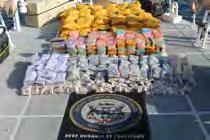
Lieutenant
the opportunity to see and conduct maritime operations from the shore, having previously spent his career at sea.
“Working with our longstanding partners from the United Kingdom was highly rewarding, and it was a great experience to meet mariners from so many different countries, see maritime operations from the other side, and work together with other nations cooperating as a coalition force.”
Navy Today #280 | 11 MIDDLE EAST DRUG BUSTS
From left: Four Royal New Zealand Navy personnel were among those deployed to the Royal Navy-led CTF 150; A French drug dog on patrol; Drugs seized during CTF 150 operations.
Michael Linehan, one of our four RNZN personnel, said the deployment gave him
MATATAUA UNIT ON EXERCISE IN AUSTRALIA
HMNZS MATATAUA’s autonomous underwater vehicle (AUV) team were among hundreds diverted from Australia’s largest military exercise after a helicopter crashed off Queensland’s coast.

The 10-person team was taking part in Exercise Talisman Sabre from 22 July to 4 August. Embarked on USS MIGUEL KEITH, a large mobile mission platform style ship, they joined the Royal Australian Navy and United States Navy AUV and clearance dive teams to form a combined mine countermeasures (MCM) task force.
The MIGUEL KEITH was re-tasked to offer search and rescue capability when an Australian MRH-90 helicopter crashed in the vicinity of the Whitsunday Islands toward the end of the exercise, killing all four aboard.
Lieutenant Jack Walters, MATATAUA Detachment Officer, says they were shocked and saddened to learn of the crash.
“The MCM task force was able to respond at best speed using personnel and MCM equipment to locate the downed aircraft.”
Prior to the tragedy, the task force was practising their response to a scenario where sea mines had been placed by belligerent forces preventing access to the key port of Gladstone. AUV teams were deployed to conduct a sonar search of the area and provide an in-depth underwater examination. This information was provided to Clearance Dive Teams to then conduct a dive to the mines to disarm or destroy them.
LT Walters said the nations’ AUV teams worked together and proved interoperability by having members swapping out into each other’s teams to achieve training objectives and share lessons learnt as well as exposing personnel to new technologies and best practices.
“With the RNZN, RAN and USN all working together for Mine Countermeasures onboard the MIGUEL KEITH, it embodied the proverb He waka eke noa, in one canoe with no exception.”
12 | Navy Today #280





Navy Today #280 | 13 MATATAUA AT TALISMAN SABRE

14 | Navy Today #280
MARLBOROUGH MOUNTAINS PROVE PERFECT TRAINING GROUND
More than 90 people supported Exercise Bluebird 23, which included Royal New Zealand Navy flight crew from No. 6 Squadron along with Royal New Zealand Air Force operations, communications and security personnel. The exercise is designed to train helicopter crews in mountain flying operations.
“The mountain ranges in the Marlborough region are perfect for our training. They provide all sorts of different valleys, bowls, pinnacles and ridges to fly around,” said Detachment Commander, Lieutenant Commander Terry Rawhiti.
“The biggest challenge we face every time we conduct mountain flying training is becoming reacquainted with the environment and getting a healthy dose of appreciation of the fact that we are, by far, not the biggest thing in the sky.

Navy Today #280 | 15
The mountainous terrain of Marlborough provided the perfect landscape for Royal New Zealand Navy Seasprite helicopter training in August.
SEASPRITES IN THE MOUNTAINS
“Other challenges are the changeability of the weather in the mountains and the remoteness of the operating environment, both of which we train for prior to arriving on station,” he said.
The SH-2G(I) Seasprite is a maritime warfare-capable helicopter, but it is essential that crews train in mountainous terrain in order to familiarise personnel in high altitude and cold weather flying operations.

“No. 6 Squadron conducts a wide variety of tasks in support of New Zealand’s interests,” LTCDR Rawhiti said.
“Though these operations are primarily based from RNZN ships at sea, we sometimes find ourselves in mountainous environments as well, such as resupplying the Kermadec Islands to the North East or the subAntarctic Islands.
“These operations require the Seasprite helicopter to be operated in and around mountainous terrain in some of the most unpredictable flying conditions our aircrew will experience.”
While in Marlborough, the squadron assisted other Government agencies.
“We conducted avalanche reconnaissance flights around the Spenser Mountain Ranges to identify any potential avalanche risks in the area for DOC,” LTCDR Rawhiti said.
“We also supported the LandSAR team by conducting mountainfamiliarisation flights for up to 15 staff and volunteers, including insertion and extraction into remote locations, winching and airborne search procedures to train for mountain search and rescue scenarios.”

16 | Navy Today #280
“ The mountain ranges in the Marlborough region are perfect for our training. They provide all sorts of different valleys, bowls, pinnacles and ridges to fly around,”
– Detachment Commander, Lieutenant Commander Terry Rawhiti



Navy Today #280 | 17 SEASPRITES IN THE MOUNTAINS
OUR PEOPLE
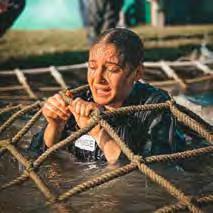
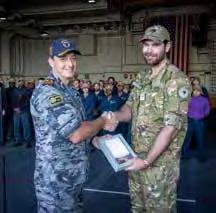
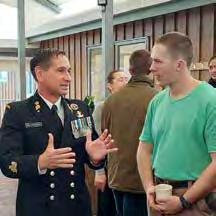
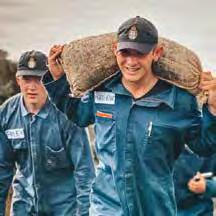



18 | Navy Today #280
POCH Kerrie Dais, Defence Recruiting, with members of the BCT 23/02 intake.
MID George Ladley, JOCT 23/02, feels the weight during a march from Army Bay at Tamaki Leadership Centre.
MIDs Oliver Foley and Theodore Matthews, JOCT 23/02, put in the hard slog at Tamaki Leadership Centre, Whangaparāoa. WODR Lance Graham, Warrant Officer of the Navy, with the BCT 23/02 intake at Te Taua Moana marae.
CMDR Richard Brickacek, Mine Clearance Diving Task Group RAN, congratulates LT Jack Walters, Boarding Officer HMNZS MATATAUA, on a successful wrap-up of exercises at Ex Talisman Sabre.
MID Hayley Ambrose, JOCT 23/02, surfaces for air at the confidence course at Tamaki Leadership Centre.
PEOPLE

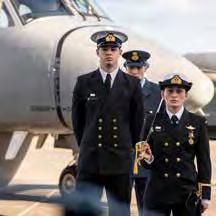





Navy Today #280 | 19
LLSS Brons Lolesi operates a forklift at the Naval Supply Depot.
OLSS Hosea Telefoni at Te Taua Moana Marae.
ACWS Dylan Crick dresses HMNZS CANTERBURY in signal flags.
OCWS Calah Fonoti at work.
Graduating from their Aviation Warfare Course are ENS Henry Collins and SLT Emma Whight.
MIDs Kamil Rahman and Wentao Dong, JOCT 23/02, hit the confidence course together.
COMPUTER SIMULATION HONES RIFLE ACCURACY

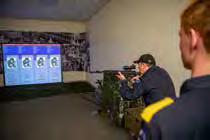
Last month personnel at Devonport Naval Base had a rare opportunity to utilise a mobile weapons training simulator, normally based at Linton. The system involves personnel ‘firing’ at a computer screen, using MARS-L rifles equipped with lowerpower lasers. The screen can project a standard target, with reductions in size to simulate a real target at greater distances, up to 800 metres. The simulator can also run scenarios, involving multiple targets and hazards in an evolving situation.
Midshipman Ben Byrant, Deputy Executive Training Officer, says while it was invaluable training for Seaman Combat Specialists and the Deployable Boarding Team, other personnel such as Defence Technology Agency staff and members of Defence Legal had a turn.
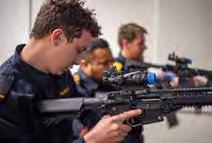
“They all wanted to see the capability and potential of simulation-based shooting and how it could be incorporated to their own unique outputs,” he says.
One big advantage of simulationbased training is information and feedback provided by the computer. “After each shot, it tells you how much your barrel is moving a few seconds beforehand. It tells you how well you are pulling the trigger, how well the buttstock is placed in the shoulder. It gives an excellent visual representation of how precious seconds could be wasted on acquiring a target or spent on getting the perfect shot. When I was using it, I was making full use of this feedback and I was able to apply these things.”
Those attending the 23/1 Able Seaman Combat Specialist Course were put to work on an instinctive reaction shoot test.
“A double-tap to each target as they appear at a range of 50-100 metres. Seems easy enough, then suddenly there’s moving targets and just as they got into the rhythm a Stoppage Drill. This stoppage caught out the majority of personnel that tried the shoot and often led to some less than impressive scores. It did however highlight the importance of perfecting the MARS-L drills and applying marksmanship techniques in a way most users hadn’t experienced before.”
Legal Officer Sub Lieutenant Daniel Bradfield praised the ability of the simulator to put personnel into Law of Armed Conflict situations and watch them make decisions. “It meant we could combine briefs with interactive and teachable scenarios, allowing us to provide our people with a deeper and more practical understanding of when they can or can’t shoot.”
Over a two-week period the simulator had more than 100 users and around 20,000 ‘rounds’ fired.
“The hope is we get it up at Devonport more frequently,” says MID Bryant.
20 | Navy Today #280
Live firing at a range certainly tests your accuracy. But a weapons simulator’s computers can graphically show you your faults, plus provide scenario-based shoot-or-don’t-shoot environments.


DIVISIONAL HUI SUCCESS
to foster a sense of belonging, strengthen team cohesion and ensure the overall well-being of personnel and their whānau.
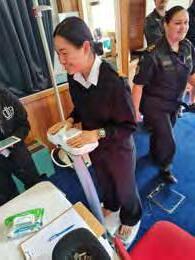
Held on 16 August, WOCWS Crosby says the hui was an opportunity to re-energise and restore the sense of community within the Navy in a faceto-face setting. The hui was open to those responsible and accountable to the Divisional System’s effectiveness with particular emphasis on Divisional Officers, NZDF Civilian managers of RNZN personnel and Divisional Senior/Junior Rates (Leading Hands and above).
With an emphasis on fun, some light physical challenges and competitions was also on hand.
“From here, to support the divisional system there will be regular updates through divisional system newsletters that will provide regular updates to ensure the information is current. We encourage, and cannot emphasis enough, how important divisional meetings are and the value they have for our sailors.
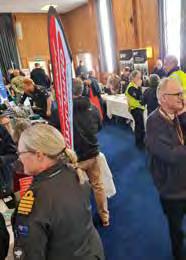
“In the wellness space we will continue being supported by the NCO newsletters and notices on Homeport and social media platforms.”
Warrant Officer Communication
Warfare Specialist Darren Crosby, Command Warrant Officer Deputy Chief of Navy, says ‘face-to-face’ Divisional Officer Seminars were a regular feature throughout the years pre-Pandemic. “This year was the first time post-COVID we were able to finally host a ‘face to face’ Divisional System Hui.”
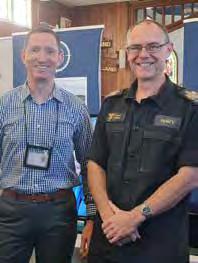
Every uniformed person in the Navy has a Divisional Officer, an officer or rating assigned with specific responsibilities, including mentorship, communication, advice and instruction. The Divisional System is designed

“The feedback we got back was really great,” he says. “Those that attended were pleasantly surprised at the amount of support as well as the variety of support offered to our defence members and their whānau.”
A Wellbeing Expo was held the following day, open to all RNZN personnel, NZDF Civilian staff and industry partners co-located on the Devonport Naval Base. “It was an excellent and relaxed platform for those that attended to meet faceto-face with experts, products and services by exhibitors who showcased a wide range of health and wellness products, services and technologies.”
On offer was information on financial products, health products, support agencies, insurance and education providers. “It was great support from our wider community.”
He says the plan is to host a face-to-face event biannually and would encourage people to attend based on the feedback on this year’s event and the importance of wellbeing in the workplace.
“People are our most important asset across the NZDF and in order to maintain high-performing teams and mission success we must look after each other and our whanau.
“Te waka eke noa – we are all in this together.”
22 | Navy Today #280
The culture of the Divisional System, the fundamental organisational structure of the Royal New Zealand Navy, has been re-energised in a recent Divisional Hui and Wellness Expo at Devonport Naval Base.
FINDING YOUR PLACE
Navy Today meets Midshipman Manukura Ngawaka, currently on his Officer of the Watch (Bravo) course.
Getting qualified and being able to have adventures and travel while earning a salary were big motivators for Midshipman Manukura Ngawaka. But he also cites his father, who joined the Navy in 1986, as an inspiration and a legacy to live up to.
MID Ngawaka, Ngati Maniototo, joined the Navy in 2022, aged 18. Finishing at Nelson College, he says there was the opportunity to study law at Otago University, but he didn’t want the extra financial burden. He says his 22 weeks of officer training was awesome.

“It definitely built resilience and it pushed me mentally when it comes to how I approach my day-to-day life. It helped me with facing problems, and how I approached them. I enjoyed the physical training, loved the weeks on the shooting range, and Exercise Storm – no sleep and being pushed every day – was awesome.”
Shortly into 2023 MID Ngawaka underwent his Initial Sea Time training in HMNZS CANTERBURY, deployed to the Kermadec Islands and Fiji.
“Being in a ship, finding your place at sea, it feels like you’re a rock in the middle of a stream, finding your way in to the flow of shipboard life,” he says.
“I was definitely grateful being able to learn invaluable lessons about ship life and it was a great learning tool going on to the Bravo course, having that real life application.”
As a warfare officer, he’s now posted to the Navigation Training School to do the Officer of the Watch (Bravo) 23/01 course. He is contemplating becoming a Mine Warfare Clearance Diving Officer in the future. “It’s a challenging role, and exciting work, but it will be hard work to get there.”
He wants to get involved in Navy kapa haka, having been a kapa haka tutor for a primary school in Nelson.
“Our group performed in the regional competitions. I was super-proud of them, and learnt a lot from teaching them. When our Navy intake did the haka at our graduation, it was a special moment for us.”
His advice to others looking at NZDF careers is “just do it. If you’re looking at the Defence Force and you’re unsure, just take it, it’s definitely not a 9–5 job”.
Navy Today #280 | 23 PROFILE
Midshipman Manukura Ngawaka
CHEFING FOR THE COAST GUARD
It was a case of Kiwiana cuisine meeting Taco Tuesdays when two Royal New Zealand Navy chefs deployed aboard a United States Coast Guard cutter for four months.

Leading Chef Monique Manuel and Able Chef Alice Wyatt are the first in what is likely to be a longstanding exchange agreement between the Coast Guard and the RNZN. The pair joined USCGC STRATTON in Hawaii for a Western Pacific patrol from April to July.

ACH Wyatt says she had asked to do a foreign exchange. “I wanted to see how other navies do things, and experience life on board another country’s ship.” When the offer came up, her friend LCH Manuel jumped at the opportunity as well.
The pair helped provide daily meals to STRATTON’s 150 crew members.
ACH Wyatt says the differences in catering was the biggest eye-opener for both of them. “We certainly learned about cooking Mexican food. They have Taco Tuesdays every week, and they are fond of burritos and chilies.” It wasn’t possible to cook a pavlova, but they tried their best to organise a roast lamb meal, something not the norm for Americans. When the wrong cuts of meat came in, the pair settled for lamb pies, which were declared delicious by the crew.
“We both fitted in well,” says ACH Wyatt. “Honestly, we got treated so well, we felt super-welcomed. The crew don’t know much about New Zealand, they think we come from the middle of nowhere. They would shout: ‘The Kiwis!’ when they saw us.”
The exchange included port visits to Tokyo, Singapore and the Philippines. “It was a great trip, with lots of really cool port visits and heaps of time in port.”
Captain Brian Krautler, Commanding Officer of STRATTON, said they were excited to have them as part of the crew.
“The crew was able to learn about their customs and courtesies as well as New Zealand traditions, plus we were able to enhance their experience while underway on an American ship.”
In May the US Coast Guard and Royal New Zealand Navy signed a memorandum of agreement detailing processes that enable the exchange of military personnel to enhance joint service objectives. There is another exchange underway and there are plans for more.
For Commander Costa Papadopoulos, Director of Strategic Engagement for the Royal New Zealand Navy, the opportunity for personnel to deploy for an extended period of time with the US Coast Guard is an incredibly valuable learning experience.
“Sailors join the Navy to go to sea, to experience new things outside their shore-based environment and to contribute to mission success,” says CDR Papadopoulos. “The strength of this military exchange is that it exposes our people to different perspectives and broadens their horizons. I’m sure they’ve come back to us with new-found knowledge, confidence and skills.”
ACH Wyatt’s advice to others is to be very open-minded. “There are big differences between our countries. Have a lot of patience and you’ll have a really great experience.”
24 | Navy Today #280
USCGC STRATTON
CUSTOMS DOGS ON DECK
The Royal New Zealand Navy teamed up to support New Zealand Customs Service’s detector dog training at Devonport Naval Base recently.
The team of five handlers introduced their dogs to moving and fixed maritime platforms including on-board HMNZS CANTERBURY as well as at the Navy’s wet side training facility and boat pontoon.

Customs Detector Dog Handler Cheryl says the dogs were in intermediate stage training, with her one-year-old Labrador Kiwa being operational for only two months.
“It’s an invaluable experience to get the dogs on to the larger vessels and the training platform. It gives us the full range of the types of vessels we need to train on, in a controlled environment, particularly with these very young dogs who haven’t had experience on these vessels,” she says. The training included navigating staircases, working at various heights and being on open and exposed platforms.
It was a chance for Thor, a two-yearold black Labrador, to continue his life-long training.
Navy Today #280 | 25 CUSTOMS DOGS PRACTISE WITH NAVY
“A handler and their dog put in hundreds of hours of training and this experience is part of that. Our dogs keep us on our toes, we never know what we’re going to come across. The strong bond we form with our dogs make operational finds extremely rewarding,” says Thor’s handler, Hannah.
Customs dogs can deploy on vessels for a number of reasons, such as searching vessels for narcotics, money and firearms.

“Our dogs may need to search people, an entire ship, or just one room. Familiarity training on vessels is really important as we need to ensure that the dogs are confident, competent and prepared when they deploy operationally,” says Hannah.

26 | Navy Today #280
HIGH SCHOOL STUDENT IN RESERVE FORCE
By MID Phil Barclay HMNZS PEGASUS
Christchurch 17-year-old Tim Avery is relishing the comradeship and commitment the Navy Reserves has offered since attesting in June.
Ordinary Maritime Trade Operations Avery, in his last year at St Bede’s College in Christchurch, is part of the NRCT 2–01 cohort, the second naval reserves common training intake since training recommenced after several years in 2021.

Seeking a new challenge, OMTO Avery joined after spotting the opportunity on the NZDF website.
“After I’d started the recruitment process, I found out an uncle was a Sub Lieutenant in the Reserves about 30 years ago. My grandfather served as a wireless operator in the RNZAF in Fiji and Tonga during World War II.
“It was really the idea of challenging myself. Physical fitness is a big thing for me and I have a general interest in the Defence Force and the skills I can get out of it. Even the smaller skills like ironing, I’ve not done much of before.
“The brotherhood and communitymindedness at St Bede’s is evident in the Navy as well. My mates at school are really supportive and respect what I’m doing.
“The camaraderie in the intake is outstanding. It’s great how everyone just gets around each other. The first weekend training getting to know everyone was awesome, and a bit of a shock to the system. The next tenday residential picked up where the first weekend left off and was full of fantastic experiences, including ship visits to TE KAHA and CANTERBURY,” he says.
OMTO Avery is intending to study finance at Otago University next year, and is looking forward to continued involvement with the Navy Reserve while in Dunedin at HMNZS TOROA.
“I’ve been told I can transfer, which is great, and going on deployment someday would be awesome, but that’s very much in the future,” he says. Further weekend trainings are scheduled for NRCT 23–01 through the rest of the year, including weapons qualification and sailing. The ratings will complete training in March and graduate with the officers in June.
Ordinary Maritime Trade Operations Tim Avery
HIGH SCHOOL STUDENT IN RESERVES Navy Today #280 | 27

Navy Captains’ Hui
Last month 15 of our Navy Captains came together at Devonport Naval Base for the 2023 RNZN Captain’s Hui. The day was co-hosted by the Maritime Culture project team and the Office of Deputy Chief of Navy with the intent of building connection/whanaungatanga, collaboration, and communication across this important senior cohort.
The day began with breakfast and a guest speaker – Cameron George, CEO of the Warriors. Cam spoke to the group about his journey navigating the Warriors through the COVID-19 pandemic, the importance of communication, putting people first, and the power of knowing who you are as an organisation and what you stand for. The message was that the Warriors’ recent success on the field was all about their culture and the work being done off the field. Next the group headed into a series of roundtable discussions with Deputy Chief of Navy, Maritime Component Commander and the Command Warrant Officers (CWOs) supported by the Junior Leadership Advisory Board (JLAB). Warrant Officer Communication Warfare Specialist
Darren Crosby, DCN’s Command Warrant Officer, said it was “a great opportunity to advise the cohort on some of the tactical and operational realities of our force, work through the challenges together and celebrate the wins. People, communication, and alignment were strengths drawn from the session”.
After lunch the group spent some time together brainstorming how to leverage opportunities and collaborate more on some of our challenges as an organisation. Maritime Culture Guardianship Group Co-Chair, Captain Simon Griffiths RNZN noted it has been some time since all available Captains had been together. “It was an awesome chance to be able to openly and honestly share perspectives and ideas, and to
discuss how we can best continue to support positive change throughout the RNZN.”
The day was closed out with a team building exercise run by Sea Safety Training Squadron in the Damage Control Training Unit to further emphasise the themes of the day. It provided everyone with a refresh of key damage control skills, but more importantly reinforced the need for strong connection, smart collaboration, and clear communication. While the incident required them to abandon ship, the team were pretty competent in the flood unit, and there were plenty of laughs and smiles before, during and after the activity.
NAVY CAPTAINS’ HUI
Photo on staircase: (From the bottom) CAPT Lisa Hunn, CAPT Phil O’Connell, CAPT Clive Holmes, CDRE Andrew Brown, CAPT Owen Rodger, CAPT Colleen Smith, CAPT John Sellwood, CAPT James Barnes, CAPT Brendon Oakley, CAPT Simon Rooke, CHAP Pete Olds, CAPT Simon Griffiths, CAPT Maxine Lawes, CAPT Shane Arndell and CAPT Euan Henderson.
Navy Today #280 | 29
IN COMPANY WITH INDIA
HMNZS TAUPO enjoyed the rare opportunity to conduct a formation departure from Auckland with Indian Navy guided missile destroyer INS KOLKATA, following a fourday visit by the destroyer and frigate INS SAHYADRI last month.
The ships were in New Zealand on a four-day resupply and goodwill visit, with SAHYADRI calling into Wellington. Chief of Navy, Rear Admiral David Proctor, hosted Captain Sharad Sinsunwal of KOLKATA at Devonport, while Deputy Chief of Navy, Commodore Andrew Brown, hosted Captain Rajan Kapoor of SAHYADRI in Wellington.
TAUPO was able to carry out Officer of the Watch manoeuvres and some further in-company training with KOLKATA. Lieutenant Samara Mankelow, Commanding Officer, had the ship fly their Battle Ensign (a larger than usual White Ensign), something often ordered to be hoisted for photos on Exercises. An Indian Navy ship last visited in 2016, during the International Naval Review.
VISITS TO NEW ZEALAND BY INDIAN SHIPS
1951 INS RAJPUT (ex HMS ROTHERHAM)
1969 INS DELHI (ex HMNZS ACHILLES)
2001 INS JYOTI
2001 INS MUMBAI (ex INS BOMBAY)
2006 INS TABAR (ex INS TOOFAN ex SIKKIM)
2009 INS MHADEI
2016 INS SUMITRA
Source: Peter Cooke (2023) Ships of War in New Zealand Waters; 380 years of naval activity. Defence of New Zealand Study Group.
Below: INS KOLKATA and HMNZS TAUPO

30 | Navy Today #280
MERCHANT NAVY SAILOR RECOGNISED FOR WAR EFFORT
By Steve Watts
Clarrie Nilsen’s family have been presented their late father’s World War II service medals.
Able Seaman Clarence ‘Clarrie’ Newbridge Nilsen 3783, from Nelson, joined the New Zealand Merchant Navy at the age of eighteen and then spent the next two years and four months at sea in support of New Zealand and her allies.
While Nilsen’s sea service was titled ‘home service’ and mainly in New Zealand coastal waters, German surface raiders and submarines of the German and Imperial Japanese navies saw the laying of sea mines within main sea-lanes and attacks on merchant ships.
Speaking with Able Seaman Nilsen’s son Jeff Nilsen, there was the general feeling by many New Zealand Merchant Navy personnel that their service was never acknowledged in the manner of those who joined the Navy, Army, and Air Force.


He said the family’s original request made for their father’s World War II medals was declined by NZDF even though members of the New Zealand Merchant Navy have always been entitled to these awards.
At the official presentation of the medals in Nelson, Commander Alex Haughey of the Royal New Zealand Navy recognised his service and the importance of the Merchant Navy towards the war effort. Additionally, Barry Pont of the Nelson Returned and Services Association took the opportunity to apologise for the fact that Nilsen had not been welcomed into the RSA after World War II and presented Nilsen’s family with his RSA Membership Badge.
The family received Nilsen’s 1939–1945 Star, War Medal 1939–1945, and New Zealand War Service Medal 1939–1945.
Captain Murray Lister of the Merchant Navy Association spoke about life at sea, which demanded the highest level of seamanship, navigation, and engineering skills.
New Zealand history records life as a mariner as hard work – but also full of adventure. Merchant seafarers often found themselves in the front lines of the war at sea. Many ships were torpedoed or bombed; survivors sometimes spent days or weeks in lifeboats before being rescued. More than 140 New Zealand merchant seafarers lost their lives, and a similar number were taken prisoner. No other group of New Zealand civilians faced such risks during wartime.
Merchant Navy Day is this month –3 September – and commemorated in Nelson annually at Anzac Park by the New Zealand Merchant Navy Association and the RSA, as well as across New Zealand.
MEDALS FOR MERCHANT NAVY VETERAN
Navy Today #280 | 31
Above: Clarrie Nilsen
Army vs Navy Women: ACH Nadia Mwila (Navy), 2LT Elese Russell (Army), PTE Rosemary Reed with the ball (Army) and ENS Hannah Larsen (Navy).
Photo credit: Gary Fraser / Planet Hockey
NAVY ON TOP IN HOCKEY
Navy swept the field in the 2023 Interservice Hockey Tournament last month, with both men’s and women’s teams winning their respective tournaments against Army, Air Force and NZ Police.
The tournament, totalling 141 personnel, was played out at the National Hockey Centre in North Harbour over 14 to 18 August. Day one in the men’s competition saw Navy beat Police 3–0 while Army and Air were locked at 2–2 at full time with Army winning the shootout 3–2. In the women’s competition Police beat Navy 3–0, while Army beat Air 1–0. Day two in the men’s competition saw Navy beat Air 5–0 while Police and Army drew 1–1 with Army winning the shootout 3–2. In the women’s competition Navy women beat Air women 2–0 while the Police beat Army 3–1. Day three in the men’s competition saw Air beat Police 3–1 while Navy beat Army 5–3. In the women’s competition Police beat Air 2–0 while Navy beat Army 2–0.
During the tournament closing function W/O (Rtd) Brian (BK) Read, Patron of RNZAF Hockey presented LTCDR Jan Peterson, captain of the Navy men’s team with the Read Trophy as winners of the men’s interservice tournament. BCDR AK GPCAPT Mike Cannon then presented POET Tamara Dudley, captain of the Navy women’s team with the Sam Kereama Memorial Trophy as winners of the women’s interservice tournament, NZ Police with the Ces Cameron Cup – Spirit of Hockey Award, LTCDR Jan Peterson with the Army Hockey Association Trophy as the men’s MVP, CPL Jade Forman (RNZAF) with the RNZAF Hockey Association Trophy as the women’s MVP and Mr Angus Griffin (RNZAF) with the Navy Hockey Club Trophy as the most promising player. GPCAPT Cannon then presented LTCDR Jan Peterson, captain of the Navy men’s team with the Pope Trophy as winners of the men’s combined services competition and the captain of the NZ Police women’s team with the Sommer Trophy as winners of the women’s combined services competition.
NZDF HOCKEY TEAMS NAMED:

WOMEN: PO Tamara Dudley (Coach, PO Jeremy Rees (Asst Coach), A Sienna-Marie King (new cap), PO Alex Carter, PO Samantha-Joan Scothern, ENS Hannah Larsen, A Paige Harvey (new cap), A Petra Dye-Hutchinson, A Nadia Mwila, L Kesia Coutts (all RNZN), W/O Ann Clarkson (Manager), AC Kristen Smith, CPL Nicola Murray, CPL Jade Forman, LAC Alice Roughan (new cap) (all RNZAF), CAPT Sandra Mitchell, LT Toyah Churton (new cap), 2LT Elese Russell, WO2 Diane Kareko, LCPL Rosemary Reed, LCPL Ariana Blackwood (all NZA).
MEN: FLTLT Jake Bullot (Coach), SQNLDR Dave Timbs (Trainer), CPL Daniel Boustridge, LAC Byron Buys, FLTLT Jamie Besley, Mr Angus Griffin (new cap) (all RNZAF), MID Alex Eichelbaum (new cap), O James Harris (new cap), A Myles Vos, LTCDR Jan Peterson, A Chavez Rahurahu, O Harrison Kemp (new cap), LTCDR Ambrose O’Halloran (all RNZN), SGT Craig Culver (Manager), SIG Robert Belchamber, SPR Amiri Downs-Williams (new cap), LCPL George Littlejohn, PTE Dylan Muggleston, LCPL Brad Collins (new cap), LCPL Tux Tukapau and LCPL Kent Horsley (all NZA).
32 | Navy Today #280
AUGUST SPORTS RESULTS
RUGBY LEAGUE
Navy beat Army to win 2023 Interservices – First time in 10 years
Navy has held the Mad Butcher Trophy and Otene Waaka Cup (Army vs Navy).
VOLLEYBALL
Navy Women defeated Army to win the 2023 Interservices Volleyball.
Army men defeated Navy Men 3–0 in highly entertaining game.
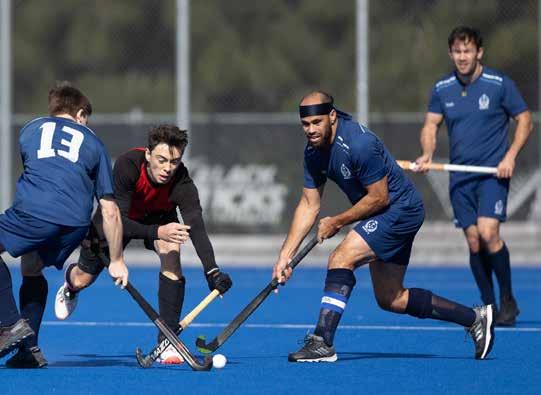
AWTR Monica Motuga, ACSS Sanaa Tupuivao & OCWS Sina PorterSamuels were all named in the woman’s tournament team.
LTCDR Andy Robinson and WOPTI Chris Attrill were both named in the men’s tournament team.
OTHER SPORTS NEWS
Navy people representing New Zealand:
LWTR Sheridan Wills recently returned from Indoor Netball World Cup Hosted in Brisbane, Australia, 12 to 19 August 2023 where he represented NZ Open Mixed Netball Team.
The team played two tournaments with a total of 20 Games, Super 6’s and Super 7’s.
• Sheridan won a Silver Medal losing in the final to Australia and was voted 2nd Place in the MVP Voting for player of the tournament.
• Sheridan picked up another Silver Medal in the Super 7’s, also going down to Australia in the final.
LT Laura Fisher was recently selected in the NZ Premier Women Team for the Black Dragons at the World Dragon Boat Racing Championships in Pattaya, held on 7–13 August this year. Overall New Zealand brought home three silvers and two bronze medals which is an incredible achievement for a small contingent. Laura’s team came away with a credible 9th for the 2km, 6th for 500m, and missed the cut for the grand final for 200m by 0.005 seconds.
ACSS Deanne Read has been selected to represent New Zealand in the upcoming Boxing Olympic Qualifiers. Which also means she has been selected for 2024 Olympic Long list. Deanne now has a busy period ahead as she needs to meet eligibility criteria to qualify, specifically:
• North America Tour/Canada Test Match (23 Sept–15 Oct).
• Pacific Games, Solomon Islands (19 Nov–1 Dec).
In July this year at the NZ track and field champs competition SLT Annie Arlidge placed 1st in the 3000m steeplechase, 2nd in the 5000m, 3rd in the 1500m all in the same weekend! Annie also placed 1st in the senior woman category at the NZ cross-country champs (10km) as well as running the anchor leg for her North Harbour Bays mixed crosscountry relay to help them win the inaugural senior NZ Cross Country Relay Championship crown. Annie recently represented New Zealand at the 2023 world cross-country championships in Bathurst where she finished a creditable 10th. Annie now has preferred selection for world cross country 2024 as a result of her highperformance at the 2023 champs.
INTER-SHIP WINNERS
Inter-Ship Basketball
HMNZS MATATAUA
Inter-Ship Hockey
HMNZS CANTERBURY
Inter-Ship Netball
HMNZS MATATAUA (competitive winners) & HMNZS AOTEAROA (social winners)
Inter-Ship Volleyball
MT’s (competitive winners) & BBT’s (social winners)
UPCOMING SPORTS
28 AUG–1 SEP
Interservice Netball
Waiouru (Army)
1–10 SEP
Interservice Football Auckland (Navy)
5–8 SEP
Ski/Snowboard Champs
Whakapapa Ski area
12–13 SEP
RNZN Squash Champs
Devonport Squash Club
15–17 SEP
Invitational Interservice Squash
Devonport (Navy)
27 SEP
RNZN Birthday Tabloid
8 NOV
Inter-ship drone skills competition
Fleet Gym
29 NOV
Navy Half Marathon
13 DEC Champion of the Navy (fleet Tabloid)
Army vs Navy Men: OET James Harris (Navy), LCPL Kent Horsley (Army), LTCDR Jan Peterson (Navy), LTCDR Ambrose O’Halloran (Navy).
SPORTS Navy Today #280 | 33
Photo credit: Gary Fraser / Planet Hockey
LET Joshua Ashby
LTCDR Alexandra Barnett
ENS Adam Barron
LTCDR George Blackmore
LET Josh Boer
LT Jo Boocock
ENS Logan Bray
CPOWT Shawn Brenchley
ENS Holly Casey
LTCDR Eric Chapman
POEWS Deryck Edie
POMT(L) Codie Edmiston

LSCS Ashlea Farrar
AHSO Cleo Ford
A/CPOHST George Forrest
LTCDR Matthew Gajzago
PODR Shane Gardiner
LT Peter Gee
Congratulations on your promotion (8 June to 10 August 2023)
POYDS Melissa Gilmartin-Kara
POET Liam Godfrey
A/LT Hamish Hahunga
LSTD Lee Hall
LMT(L) Shaun Harden
A/CPOHST Ryan Hulse
POMT(P) Hayden Jenkins
ENS Brock Longworth
LMT(P) Taverio Mauala
A/CPOPTI Te Teira Maxwell
POLSS Jason Morrison
LT Nick Moses
POLSS Emarina Nikora
A/LTCDR Matthew Patten
LLSS Gary Poi
ENS Ben Redmond
POYDS Simon Reffin
CAPT Owen Rodger
A/LHST Jock Rosie
LMT(P) Brent Salisbury
LMT(P) Keegan Sangster
ENS Stevin Shaji
LT George Sinclair
AET Elijah-Juan Tameifuna
A/LTCDR Poutu Taua
A/LSTD Vegas Tipoki
AWTR Irinieta Toduadua
POHLM Jesse Turi
LSCS Calvin Van de Geer
CPOSCS Angus Wells
ENS Aiden Wild
ENS Rachael Willison
PROMOTIONS:
Visit vote.nz or call 0800 36 76 56 Enrol, check or update your details now for the 2023 General Election. Voting in New Zealand starts on Monday 2 October. Overseas voting starts on Wednesday 27 September. THE 2023 GENERAL ELECTION 34 | Navy Today #280
01
ROUNDS CAPTAIN OWEN RODGER
Job Title and description:
Maritime Regulator and Naval Flag Administrator. My role is to manage Seaworthiness on behalf of the Chief of Navy.
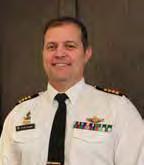
02
03
Date Joined RNZN:
I joined the RNZN on 01 Jun 2007 when I transferred from the RNZAF, which I joined 11 Jan 1994.
First ship posted to:
I joined a number of ships for short periods to train pilots but my first ‘real’ posting was as Flight Commander, HMNZS TE MANA in 2007.
04
Best deployment and why:
Op Tiki to the Persian Gulf in 2008. That deployment was a great way for me to really understand the Navy, operating in the maritime environment, and I got to deploy with a great crew of sailors.
05
Hometown: Waimauku in North West Auckland.
06 High School: Darfield High School, Canterbury.
07
08
Favourite book: Jonathan Livingston Seagull.

Favourite movie: The Usual Suspects.
09
10
11
Favourite album: Chisel by Cold Chisel.

Favourite song: Rocket Man by Elton John.
Favourite holiday destination:
Anywhere new with my family – travelling somewhere different is always interesting.
12
13
Outside of work, what's the one thing you enjoy doing?
I’m a keen snowboarder – albeit a novice at it.
What's something about you that not many people know?
I’m not that comfortable with heights... strange for a pilot I know.
14
A person that taught you a valuable life/Navy lesson… and the lesson was?
I’ve been taught valuable lessons by a number of Helicopter Loadmasters who have repeatedly shown me that the best ideas can come from the most junior and inexperienced crew member. Good leaders listen to opinion from everyone and find the best answer – and Loadies are certainly happy to tell you what they think!
15
How would you describe the Navy in 10 words or less?
Adaptable, Capable, and Responsive because of our Sailors.
15 ROUNDS 15
Navy Today #280 | 35
